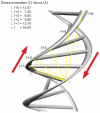DNA shape, genetic codes, and evolution
- PMID: 21439813
- PMCID: PMC3112471
- DOI: 10.1016/j.sbi.2011.03.002
DNA shape, genetic codes, and evolution
Abstract
Although the three-letter genetic code that maps nucleotide sequence to protein sequence is well known, there must exist other codes that are embedded in the human genome. Recent work points to sequence-dependent variation in DNA shape as one mechanism by which regulatory and other information could be encoded in DNA. Recent advances include the discovery of shape-dependent recognition of DNA that depends on minor groove width and electrostatics, the existence of overlapping codes in protein-coding regions of the genome, and evolutionary selection for compensatory changes in nucleotide composition that facilitate nucleosome occupancy. It is becoming clear that DNA shape is important to biological function, and therefore will be subject to evolutionary constraint.
Copyright © 2011 Elsevier Ltd. All rights reserved.
Figures



References
-
- King MC, Wilson AC. Evolution at two levels in humans and chimpanzees. Science. 1975;188:107–116. - PubMed
-
- Dobzhansky T. Nothing in biology makes sense except in the light of evolution. American Biol Teacher. 1973;35:125–129.
-
-
Parker SCJ, Hansen L, Abaan HO, Tullius TD, Margulies EH. Local DNA topography correlates with functional noncoding regions of the human genome. Science. 2009;324:389–392. ••This paper introduced a new method for assessing evolutionary constraint based on DNA shape, and showed that more than 10% of the human genome is under selection for structure. Of particular significance is the finding that a high proportion of functional genomic elements occur in regions that are under structural constraint.
-
-
-
Itzkovitz S, Hodis E, Segal E. Overlapping codes within protein-coding sequences. Genome Res. 2010;20:1582–1589. •• This study presents a clever method to measure information content in coding sequences. The authors found that across diverse phyla coding sequences encode information beyond the standard genetic code.
-
Publication types
MeSH terms
Substances
Grants and funding
LinkOut - more resources
Full Text Sources

